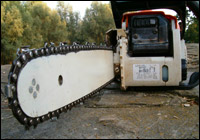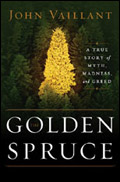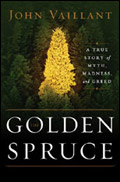The old riddle goes: If a tree falls in a forest and no one’s there to hear it, does it make a sound? The new one might go: If a tree falls in a forest and no one’s there to hear it, is it worth writing a book about?
John Vaillant thinks so. That’s why the first-time author spun a New Yorker essay into the recently published The Golden Spruce: A True Story of Myth, Madness, and Greed.
The book centers on the dark-of-night destruction, in 1997, of a rare Sitka spruce in British Columbia’s rugged, outlying Queen Charlotte Islands. The massive, 300-year-old tree — which sported golden needles in the midst of a verdant forest — was revered by the local Haida people, protected by the province’s otherwise-voracious logging industry, and gawked at by tourists (who could even stay at the Golden Spruce Motel). But all that came to an end when a disgruntled, semi-psychotic timber surveyor cut the tree down.
Grant Hadwin’s action was intended as a protest against unconscionable old-growth logging in B.C. — the “Brazil of the North” — but it was met with outrage across the province, and eventually (thanks in part to Vaillant’s magazine coverage in 2002) across the continent. Hadwin upped the fascination and furor when he disappeared in a kayak on his way to stand trial for the arbicide; his gear was discovered several months later on a nearby island, and his whereabouts remain unknown.
Using the oddly compelling college-lecture style familiar to readers of The Perfect Storm and Into the Wild, Vaillant transforms one man’s misguided act into a tapestry of history, anthropology, biology, and industry. In fact, even though it’s marketed as “an astonishing true story of a furious man’s obsessive mission against an industrial juggernaut,” this book is not about Hadwin — he doesn’t even appear until page 87. True to its title, this book is about a tree.
Once it becomes clear that the first few chapters are not an interminable introduction to the action, but are the action, the setup is easier to savor. The story of a tree becomes the story of people and place and time, and Vaillant — a Massachusetts native who lives in Vancouver — takes readers all over the world, from the once-forested limestone slopes of Greece to the pine groves of Maine. His descriptions of the Queen Charlotte Islands and the Haida people are, fittingly, the most vivid. He paints a moss-draped world where salmon are stranded in branches and seabirds nest in roots; where a native community struggles to relearn dances and traditions once wrested away; where trees take, as one logger puts it, “800 years to grow, and 25 minutes to put on the ground.”

Chainsaw of fools?
Photo: Radek Siechowicz.
More than anything, The Golden Spruce serves as a mildly disguised, highly digestible exploration of the timber industry. It reminds us that wood was once “as valuable as an oil field or a uranium mine today: it was a critical source of energy … without which a nation could not fully realize its commercial or military ambitions.” Through colorful, if somewhat scattershot, interviews with present-day loggers, Vaillant reveals the perils of the dwindling, but still-vital, trade — both for the forest and for the workers whose livelihoods depend on it. His sometimes wide-eyed excoriation of clear-cutting can be forgiven for the other facts he brings to light: the word “lumber” originally meant something useless and cumbersome, for instance, and lighthouses were once considered for Oregon’s Willamette River, to pierce the smoke of forest fires.
Vaillant’s language is fresh, at times; we get images like “the long, tree-stubbled lip of the continent,” and moments like this: “For generations, loggers have been viewed as a kind of subspecies that requires special handling, like boxers or British football fans.” Just as some turns of phrase soar, though, others land with a thud. On the ax: “This crude but effective tool originated in the Stone Age and yet it has remained in wide usage throughout the world ever since.” On biology: “Chlorophyll is the green pigment in leaves and needles and it is what makes photosynthesis possible.”
Ultimately, reading The Golden Spruce is a bit like visiting a museum: at the beginning, enamored with every splash of color, you pledge to give each piece its due. By the end, you focus on the stuff you like, and hope you’ll remember one thing you saw. At one point, Vaillant’s description of the islands could just as easily apply to his own work: “a concentration of what one might call geographic essence, as if the nature and spirit of a much larger region were compressed into a space too small for it to plausibly hold.”
Like any good curator, Vaillant — who counts among his influences such mythmakers as David McCullough, Joseph Campbell, and Herman Melville — says he wants “to invite people who wouldn’t ordinarily care and think about this stuff to think and care about it.” And that’s why this is marketed not as a book about forestry and environmental issues, but a book about myth, madness, and greed. In the end, it’s both. A reviewer for Canada’s CBC offers the most fitting conclusion: “It seems about right that it should be our homegrown answer to the blockbuster danger book,” Andrea Curtis writes. “It’s a true Canuck tale: man versus nature, but not too flashy, and hard to define in traditional terms.”



